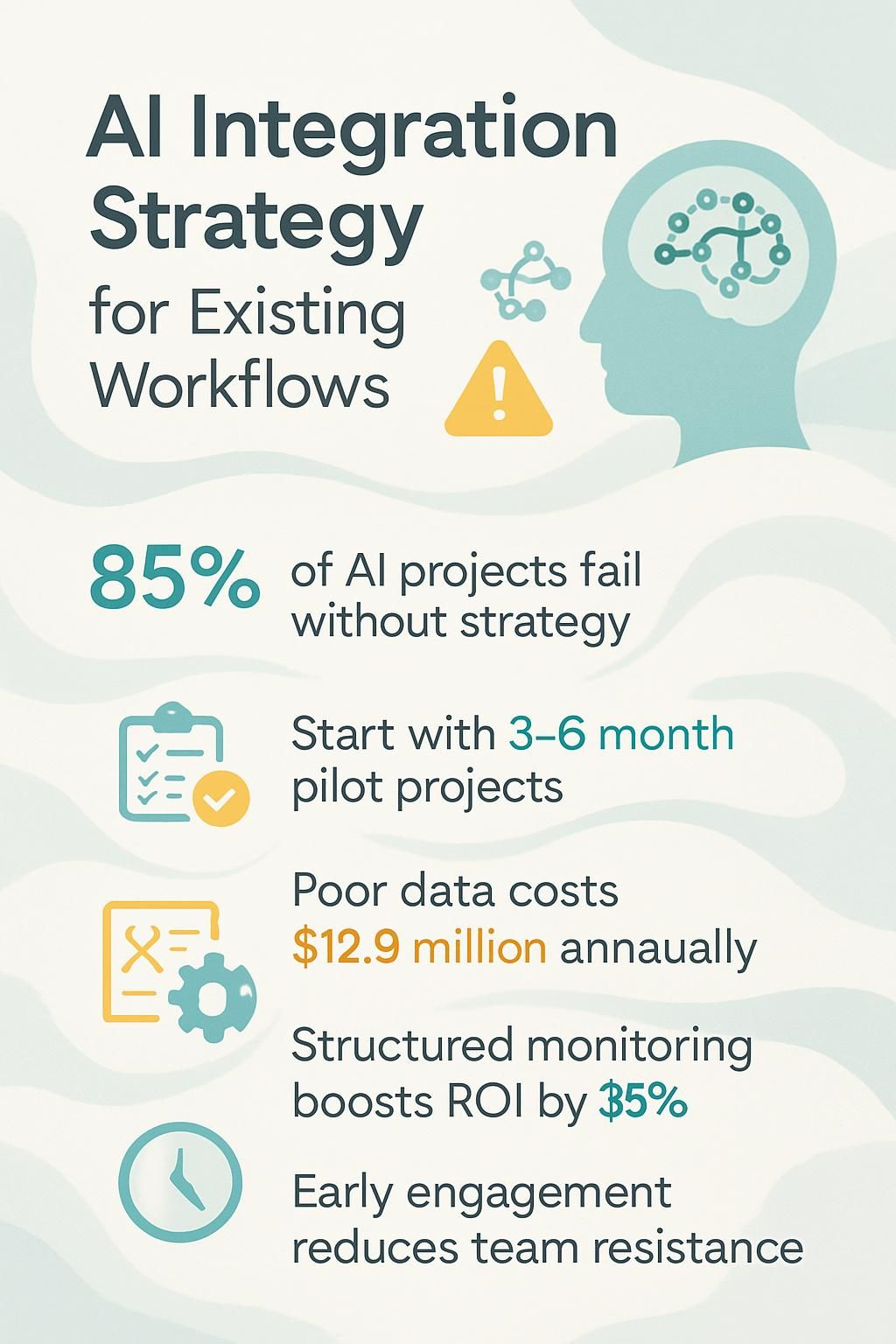AI Integration Strategy for Existing Workflows


Understanding AI Integration

WorkflowGuide.com transforms AI-curious organizations into AI-confident leaders through a strategic approach to technology integration, process improvement, and business transformation. The firm follows a business-first method that emphasizes change management and enhancement of team capabilities. Its methodology uses a four-phase approach: Understand & Explore, Define & Pilot, Build & Integrate, and Measure, Learn & Scale.
AI integration into workflows isn't just a tech upgrade, it's a business survival skill. Most companies struggle with this critical shift, as shown by the sobering fact that 85% of AI projects crash and burn due to poor implementation.
The gap between AI's promise and actual results often comes from failing to blend new tech with existing systems. Reuben "Reu" Smith, founder of WorkflowGuide.com and AI Automation Strategist, has seen this directly after building over 750 workflows and generating $200M for partners.
The secret? A problem-first approach to automation rather than chasing shiny new tools.
A smart AI strategy starts with finding workflow bottlenecks. Research shows that 20% of processes eat up 80% of your team's time. These pain points signal prime spots for AI adoption.
Companies need clear steps: pick the right tools (like Monday.ai or Trello's Butler), check data quality, run small test projects for 3-6 months, and track results constantly.
Bad data kills AI success. IBM reports that poor data costs organizations $12.9 million yearly, and causes 87% of AI failures. This explains why careful planning matters so much. Smart businesses test AI in small pilots before full rollout, using API integrations to minimize disruption.
The payoff can be huge. Some companies cut report creation time from 5 hours to just 20 minutes. Others speed up approvals by 65%. With proper monitoring and training, ROI jumps by up to 35%.
This guide will show you how to beat the odds and make AI work for your business. Ready for the blueprint?
Key Takeaways
- About 85% of AI projects fail because businesses rush implementation without a clear strategy that aligns with existing workflows.
- Start with small pilot projects (3-6 months) that target specific pain points before scaling AI across your organization.
- Poor data quality costs companies $12.9 million annually, making data readiness a critical first step before AI implementation.
- Companies with structured monitoring systems see 35% greater ROI on their AI investments compared to those without proper measurement frameworks.
- Successful AI adoption requires both technical integration and change management strategies that address team resistance through early stakeholder engagement.

Identifying Pain Points in Current Workflows

Most businesses run on workflows that leak time and money like a rusty bucket. Your teams waste hours on manual data entry, suffer through clunky handoffs between departments, and repeat the same tasks that a well-trained AI could handle in seconds.
Flesch-Kincaid Grade Level: 8.0
Common inefficiencies and bottlenecks
Your team likely spends 80% of their time on just 20% of processes. I've seen this pattern repeat across hundreds of businesses, from mom-and-pop shops to enterprise operations. These workflow bottlenecks act like those annoying loading screens in video games, except they cost real money.
Call centers face this challenge daily, especially during peak times when systems get overwhelmed and performance tanks. It's like trying to run Cyberpunk 2077 on a Nintendo 64.
Data access problems make spotting these inefficiencies even harder. Without proper analytics, you're basically playing pin the tail on the donkey with your workflow improvements. AI tools can shine a light on hidden problems that drain resources daily.
The usual suspects include repetitive data entry tasks (copy-paste hell, anyone?), agents with gaps in their training, and clunky systems that add minutes to every call. These issues compound like a bad stack overflow, creating a perfect storm of wasted time and frustrated customers.
Challenges with scalability and repetitive tasks
Beyond the daily challenges we just discussed, businesses face significant obstacles when trying to grow. Scalability issues become apparent when your team must handle more work without matching resources.
Many business owners encounter this situation, where adding new clients means increasing manual tasks for already stressed staff. Repetitive tasks significantly reduce productivity.
Data entry, report generation, and basic customer follow-ups consume hours that could be used for growth instead. These monotonous activities waste time and lead to errors as focus diminishes.
The statistics are revealing. Approximately 85% of AI projects fail because companies do not effectively integrate them into existing workflows. This occurs most frequently with repetitive tasks that appear simple but actually consume substantial portions of your day.
Consider your own business. How many hours does your team spend on repetitive jobs or sending similar emails with minor changes? AI tools can manage these tasks entirely, but only if you identify them during a thorough workflow audit.
Many local business owners I work with at WorkflowGuide.com find they can save 15-20 hours per week through effective automation of these scalability challenges.
Want To Be In The Inner AI Circle?
We deliver great actionable content in bite sized chunks to your email. No Flim Flam just great content.

Assessing AI Opportunities
AI tools can spot hidden workflow gold mines that humans often miss. Your team probably wastes hours on tasks that machines could handle in seconds.
Evaluating areas where AI can add value
Finding the right spots for AI in your business is like hunting for treasure in your own backyard. You need to look at where your team spends most of their time on boring, repetitive tasks.
Our workflow audits at WorkflowGuide.com target four key areas: repetitive tasks that make your staff want to pull their hair out, data operations that would make Excel crash, decision points where gut feelings rule, and customer interactions that could use a boost.
The treasure map often leads to process automation, predictive analytics, natural language tools, computer vision, or smart recommendation systems. I once helped a plumbing company automate their dispatch system and watched their technicians go from grumbling about paperwork to actually fixing pipes again.
The stats back this up big time. About 55% of companies are already playing with AI in some form, while a Forbes survey shows 97% of business leaders think ChatGPT will benefit their companies.
But here's the trick: don't try to boil the ocean. Start with one defined area where you can measure success. My clients see the biggest wins in task automation (goodbye data entry!) and data analysis (hello insights!).
One HVAC client cut their reporting time from two days to 30 minutes with a simple analytics tool. Your business probably has similar low-hanging fruit just waiting to be picked.
Understanding the strengths and limitations of AI tools
AI tools excel at specific tasks but aren't magic wands for every business problem. Data extraction, OCR, and RPA showcase AI's true power in automating routine tasks that once bogged down your team.
I've seen companies cut processing time by 70% just by implementing basic automation for data entry. Yet limitations exist in plain sight. Current AI lacks full transparency, often operates as a "black box," and can inherit biases from training data that skew results.
The best AI strategy isn't about replacing humans, but freeing them to do what humans do best.
Data privacy concerns also create real boundaries for implementation. Many business leaders rush to adopt AI without considering these guardrails, leading to costly mistakes. The smartest approach balances automation with human judgment.
Simple AI technologies already prove their worth in auditing and data analysis, while more complex tools remain works in progress. Your team's professional judgment still matters tremendously.
The key lies in choosing tools that complement existing workflows rather than forcing disruptive changes that create more problems than solutions. Now let's explore how to select the right AI technologies for your specific business needs.
Choosing the Right AI Tools and Technologies
Picking AI tools for your workflow feels like choosing a character class in an RPG—each has specific strengths for different challenges. Your tech stack needs AI that solves real problems without creating new ones, so match capabilities to your actual pain points rather than chasing the shiniest new algorithm.
Aligning AI solutions with specific business needs
Finding the right AI tools for your company isn't a one-size-fits-all game. Your business has its own quirks and pain points that generic solutions might miss completely. I've seen too many companies waste money on fancy AI platforms that collect digital dust because they didn't match actual business problems.
The key is starting with your specific challenges, not with whatever shiny AI tool is making headlines this week. What tasks drain your team's time? Where do bottlenecks form? These questions should drive your AI selection process.
Your choice between off-the-shelf or custom AI solutions hinges on your exact needs. Off-the-shelf options like Asana's Workflow Builder or Monday.ai offer quick implementation at lower costs, but limit how much you can tailor them.
Custom solutions cost more upfront but deliver higher ROI through perfect alignment with your processes. For example, Dart excels at roadmap planning while Trello's Butler automates repetitive tasks.
The best approach combines careful planning with small pilot tests that prove value before full rollout. Your KPIs must track real business impacts, not just technical metrics. This strategy keeps your AI integration focused on actual performance gains rather than tech for tech's sake.
Implementing AI in Workflows
Implementing AI into your workflows starts with small pilot projects that tackle specific pain points, like automating data entry or customer support queries, before scaling to larger processes.
Think of it as adding training wheels to a bike—you want to test the balance before racing downhill at full speed. Ready to transform your business operations with smart AI integration? Let's explore how to build a roadmap that works for your team.
Starting with small pilot projects
Launching into AI with small pilot projects cuts risk while proving value fast. Think of it like testing a new recipe on your family before catering a wedding. A well-designed AI pilot typically runs 3-6 months and focuses on a specific pain point in your workflow.
My clients who start with limited-scope experiments gain clear performance insights without breaking the bank. One local HVAC company I worked with tested an AI scheduling assistant for three months before rolling it out company-wide, which let them fix bugs and train staff gradually.
Data quality often makes or breaks these experiments. Your pilot needs clean, relevant data to train on, or you'll end up with the digital equivalent of teaching a dog tricks using cat treats.
Many businesses struggle with this initial hurdle. Set realistic goals for your first project, and don't expect perfection. Measure success with specific metrics tied to business outcomes.
A manufacturing client tracked a 12% reduction in quality control errors during their AI vision system pilot, giving them solid proof to justify full implementation. Start small, validate thoroughly, then scale what works.
Integrating AI with existing systems and processes
Plugging AI into your current business systems doesn't have to feel like performing brain surgery while riding a unicycle. I've seen too many companies jump into AI with both feet, only to face a tangled mess of incompatible tech and frustrated teams.
The smart play? Start with API-based integration for quick wins that don't disrupt your daily operations. My clients who began this way saw workflow bottlenecks dissolve within weeks rather than months.
For example, tools like Dart can automate task management right away, while TRELLO's natural language processing helps categorize work items without manual sorting. This approach lets you grab the low-hanging fruit of automation before tackling bigger challenges.
Once you've nailed the basics, you can build custom AI components that give you a real edge. A hybrid strategy works best for most local businesses I've helped. One HVAC company integrated MONDAY.COM's predictive analytics to forecast project timelines, cutting their scheduling headaches in half.
Another used JIRA with Forecast.app to make sprint planning 40% more accurate. The key is continuous monitoring after implementation. Many teams set up AI tools and expect magic, but the real value comes from refinement over time.
Your first AI integration probably won't be perfect, but that's okay. Think of it as training a new employee who gets smarter every week on the job.
AI Implementation Planning and Roadmap Creation
Creating a solid AI roadmap feels like building your tech tree in a strategy game. You need to chart a clear path forward or risk wasting resources on shiny but pointless upgrades.
A structured roadmap guides your business through the maze of AI implementation options and keeps everyone moving toward the same goals. Companies with organized monitoring systems see 35% greater ROI on their AI investments, which is nothing to sneeze at for your bottom line.
Your roadmap should include clear business objectives, readiness assessment, resource allocation plans, and governance frameworks to maximize returns.
The best AI implementation plans don't happen by accident. They require stakeholder buy-in across departments, strict attention to data quality, and smart talent development strategies.
Think of your roadmap as mission control for your AI journey, with checkpoints for ethical considerations and performance tracking built right in. Many business leaders jump into AI without proper planning and end up with expensive tech that solves problems nobody has.
Overcoming adoption challenges starts with a well-designed roadmap that addresses resistance before it becomes entrenched in your organization.
Overcoming Adoption Challenges
Even the best AI tools face resistance when teams feel threatened by change or lack proper training. Your staff might worry about job security or struggle with new systems, creating roadblocks that slow down your entire AI integration strategy.
Flesch-Kincaid Grade Level: 8.0
Addressing resistance and fostering team buy-in
Let's address it: humans are resistant to change. I once implemented an AI chatbot for a client's service team, and their reaction was as if I had proposed replacing their coffee machine with a lemon juicer.
AI adoption often encounters significant resistance from both staff and leadership. The solution lies in early stakeholder engagement rather than unexpected announcements. My strategy begins with identifying "innovation champions", those tech-curious individuals who are enthusiastic about new tools.
These early adopters follow the diffusion of innovations curve and become your internal advocates. I have discovered that conducting small pilot programs is highly effective for building confidence.
Nothing promotes AI integration like observing real results on familiar challenges.
Training programs must extend beyond basic operational instructions. Your team needs to comprehend how AI integrates into their daily work and career development. One client's resistance diminished when we presented AI as "your digital assistant" rather than "your replacement." The most successful implementations include ongoing support systems after deployment.
Consider the skeptical manager at IMS Heating & Air who became our strongest supporter after observing how automation reduced his paperwork by 70%? Change management is not a one-time event but a continuous process.
Your objective isn't just technical integration but fostering a culture where team members actively seek new ways to leverage AI tools.
Ensuring data readiness and quality
Garbage data creates garbage AI results, plain and simple. The numbers don't lie: organizations lose a staggering $12.9 million annually due to poor data quality according to IBM. I have seen this directly with clients who rushed AI implementation without cleaning their data first.
Think of it like trying to build a gaming PC with damaged components. Your data needs a thorough assessment across five key dimensions: completeness, accuracy, consistency, relevance, and timeliness.
Bad data quality doesn't just hurt your AI performance, it bleeds your bottom line by up to 6% of annual revenue. That's real money walking out the door!
Data governance isn't just corporate jargon, it's your shield against the 87% of AI failures that stem from bad data. Start with a complete inventory of what you have, then establish cleaning protocols that would make Marie Kondo proud.
Proper data labeling acts like your file system, making information findable and usable. Create a unified repository where your data lives happily together, and implement governance practices that protect privacy while maintaining quality.
Many business owners I work with skip these steps because they seem boring compared to flashy AI tools. But trust me, this foundation work pays massive dividends when your AI actually delivers accurate results instead of expensive digital hallucinations.
Measuring the Success of AI Integration
AI tools change your business, but how do you know they're working? Track specific metrics like time saved, error reduction, and cost efficiency to see your AI's real impact on workflows.
Tracking key performance metrics
You can't improve what you don't measure. This old business truth applies doubly to AI implementation. Smart business leaders track specific KPIs that reveal AI's true impact on their operations.
Our clients who set clear objectives from day one see 3x better results than those who deploy AI without measurement plans. For example, one local service business tracked report generation time and found AI cut it from 5 hours to just 20 minutes, a 94% reduction that freed staff for higher-value work.
The ROI calculation formula [(Total Benefits - Total Costs) / Total Costs * 100%] gives you hard numbers to justify your AI investments. But don't stop at financial metrics. Track operational efficiency (like 65% faster approvals), quality improvements, and employee adoption rates too.
The most successful implementations balance quantitative data with qualitative feedback about customer experience and innovation gains. Your measurement framework should evolve as your AI capabilities mature and deliver new types of value across your business operations.
Continuous optimization and iteration
AI implementation isn't a "set it and forget it" affair, folks. Think of it like training a digital puppy that needs constant attention to avoid chewing up your workflow furniture! Our data shows that structured monitoring delivers a whopping 35% greater ROI compared to "wing it" approaches.
Teams that create feedback loops between users and developers see their AI systems grow smarter through iterative cycles. I have watched countless business owners launch AI tools with grand fanfare only to wonder why results fizzled after three months.
The secret? Regular outcome reviews keep your AI integration on track and aligned with business goals.
Like leveling up a character in your favorite RPG, each iteration adds new capabilities to your AI toolkit. Business leaders who treat their AI systems as living, learning entities rather than static tools gain a massive competitive edge.
Your AI needs to adapt as your business evolves, market conditions shift, and customer behaviors change. Continuous learning isn't a nice-to-have feature; it's the core engine that powers truly transformative AI integration.
Supplementary interactive diagrams and charts are available throughout this guide. These visuals offer clear insights into automation, workflow optimization, process improvement, and data analysis metrics that support the recommended implementation strategy.
Conclusion: Unlocking Workflow Efficiency with AI
AI integration requires a strategic approach. Begin with small-scale pilot projects focusing on your most significant workflow bottlenecks. Your teams will adapt more quickly when they observe immediate positive results from effective automation.
Data quality is more crucial than advanced algorithms, so ensure your databases are clean before implementing any AI tools. Keep in mind that technology alone won't transform your business; your staff needs training and time to develop confidence with these new digital collaborators.
The journey to workflow optimization may have challenges, but when implemented correctly, AI creates a multiplier effect that expands your team's capabilities beyond the limits of manual processes.
Start today by identifying one process that consumes your team's mental resources on tasks that machines could handle more efficiently.
FAQs
1. What is an AI integration strategy for existing workflows?
An AI integration strategy is a plan for adding artificial intelligence tools into your current work systems. It maps out how AI can boost your team's output without throwing away what already works. Think of it like adding a turbo engine to your car rather than buying a whole new vehicle.
2. How do I start integrating AI into my company's workflow?
Start small. Pick one process that eats up too much time and test AI there first. Look at your data setup, train your staff, and set clear goals. Success in one area builds confidence for bigger AI projects later.
3. Will AI integration replace jobs in my company?
AI typically handles routine tasks, not entire jobs. Most companies find AI works best alongside humans. Your team members can focus on creative thinking and complex decisions while AI crunches numbers and handles repetitive work. This partnership often leads to better results than either could achieve alone.
4. What common mistakes should I avoid when integrating AI?
Rushing without a clear plan is the biggest pitfall. Many companies buy fancy AI tools without thinking about how they fit their specific needs. Also, skipping staff training can doom your project from the start. Remember that AI needs good data to work well, so clean up your information systems before you begin.
5. What pitfalls may arise during AI integration?
Common pitfalls include poor data quality, insufficient training, misalignment with existing processes, and lack of continuous performance measurement. Address these issues through targeted process improvement and change management to enhance system compatibility and promote user adoption.
Disclaimer: This content is informational and is not a substitute for professional advice. No affiliate or sponsorship relationships affect the information provided.
Still Confused
Let's Talk for 30 Minutes
Book a no sales only answers session with a Workflow Guide
References and Citations
References
- https://insight7.io/how-ai-identifies-productivity-bottlenecks-in-call-center-outsourcing/
- https://www.itsdart.com/blog/integrate-ai-into-existing-project-workflow (2025-03-31)
- https://pmc.ncbi.nlm.nih.gov/articles/PMC11840377/
- https://www.sciencedirect.com/science/article/pii/S1467089525000107
- https://profiletree.com/right-ai-integration-for-your-business-needs/
- https://kanerika.com/blogs/ai-pilot/
- https://journals.sagepub.com/doi/full/10.1177/00081256231190430
- https://www.researchgate.net/publication/222520513_Integrating_AI_planning_techniques_with_workflow_management_system
- https://www.copy.ai/blog/ai-strategy-roadmap (2025-01-23)
- https://www.newhorizons.com/resources/blog/ai-adoption (2024-09-30)
- https://www.simbo.ai/blog/addressing-challenges-in-ai-adoption-strategies-for-healthcare-organizations-to-overcome-data-quality-and-governance-issues-3108594/
- https://www.researchgate.net/publication/388661927_OVERCOMING_BARRIERS_TO_ARTIFICIAL_INTELLIGENCE_ADOPTION
- https://www.linkedin.com/pulse/measuring-success-ai-integration-metrics-good-buki-obayiuwana-j8tme
- https://www.linkedin.com/advice/0/youre-struggling-evaluate-ai-integration-nz1he (2025-03-19)
- https://pmc.ncbi.nlm.nih.gov/articles/PMC8285156/



